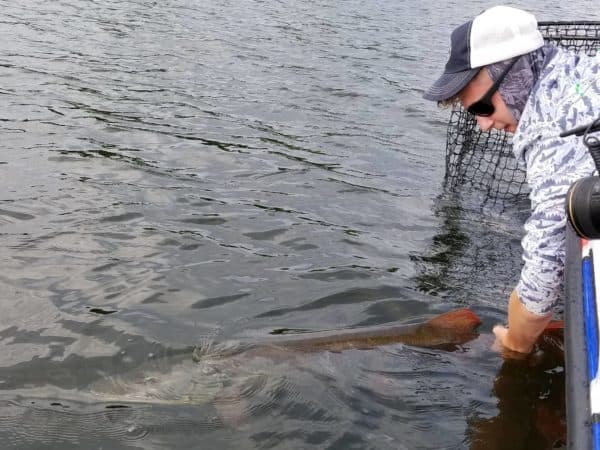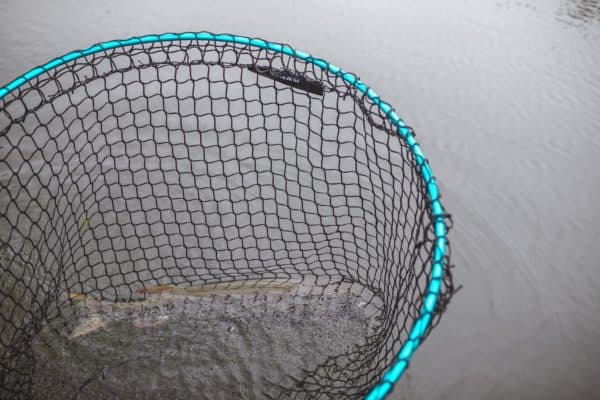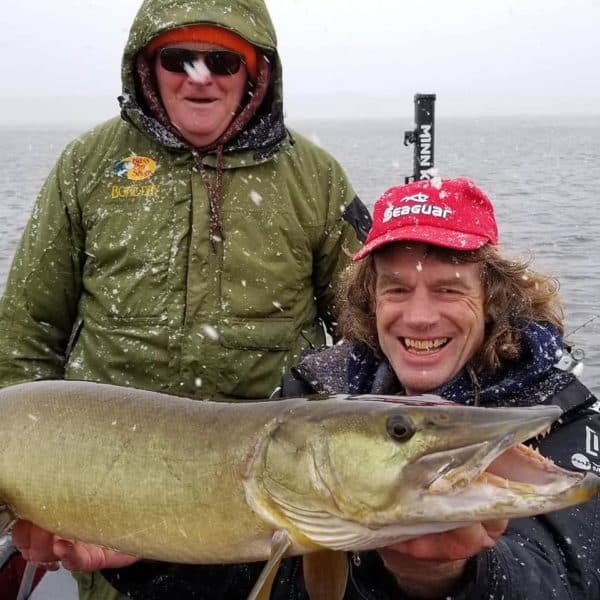Release ‘Em to Stay Alive
Category: article
Oct 24th, 2020 by sworrall
Modified Oct 24th, 2020 at 10:06 AM
Best Handling Practices for Survivability of Toothy Critters
By Pete Maina

Exactly like many good lessons learned (most importantly remembered) – the majority of my fishing lessons were learned the hard way. Many of these actually involved the catching of fish, but specifically here – I want to cover the topics of handling, release survivability and the social (media) issues involved.
When I started fishing and guiding clients (at age 14) let’s just say the playbook on proper handling, if there was one … was shut. Muskies were kept to eat, one legal (32 inches) specimen per angler a day. In general, fishing involved harvest. I can still remember when friend and Muskies Incorporated member, Mike Brandt asked me if I’d consider releasing muskies. I had never even pondered it, but having done so with his prompting, it made sense that it could be significantly easier to catch a big one if, instead of killing every one that hit the net – I let them go to get older (I had noticed a pattern of myself getting bigger as older).
Once I started the release policy …with some great pushback … it also made sense to me – that it only works well if the fish lives. Sadly, that realization didn’t make me an instant expert – and in the learning process I killed a fair number of fish … with what I know about delayed mortality now, likely more than I realized. A tradition too (like keeping ‘em) in Wisconsin was the use of live bait. Originally we let them swallow a big square hook down … doesn’t matter much when you’re going to whack ‘em with a club anyway … but a real problem for delayed mortality (likely near 100%). In the process of learning quick-strikes, I waited too long at times, lost my confidence on misses and would go back to gut hooks when using big suckers. I really don’t like pondering how many I may have killed; but eventually, with fine-tuning rigs and realizing mandatory quick hookset – was important for both hooking percentages and assuring no swallowing – for several decades now it’s the most fish friendly method I use in open water.
Measuring practices had to change from measuring in-boat on a ruler to in-water measure and eventually morphed to none at all and just estimating. This came about as I learned about water temperature (warmer the worse) effects and other stressors that cumulatively negatively affect fish – and that if too many of them come together it can result in a dead fish upon release attempt, or delayed mortality from stressor effects on immune system. Through experience I learned to be able to gauge general timeframes available to avoid high stress based on conditions (water temps, waves, current and fight time) – and to read the fish’s signs of stress if miscalculated (most reliable: petechial hemorrhaging that begins at the tail).
Let’s go over some best practices for the fish – and discuss social issues as well in recent years. (Videos on tools, proper holds, quick-strike sucker rigging are available on my YouTube Page)
PROPER TOOLS: The right tools make all the difference in proper handling – do not venture out where muskie and pike live without large (minimum 11 inch) longnose pliers, quality hook cutters (Knipex 8 inch) that allow you to easily cut hooks up to 8/0, some type of jaw spreader tool with protection for the fish’s mouth (10 inch Quarrow model works well, but cover sharp points); and a heavy welding glove (allows for grabbing by lower jaw) is not a bad idea. If a fish has taken a lure deeper, a tool to hold the mouth open is helpful (especially-so with pike as they tend to keep their mouth slammed shut). Split ring pliers and spare hooks, rings – to replace hooks that are cut quickly. Always cut any hooks near or in critical areas (eyes, gills) or just badly hooked (avoid tearing). While it’s not greatly popular with muskie anglers, pinching barbs on hooks avoids all of these issues – and if anglers end up hooking themselves … you will really appreciate going barbless.
Landing devices are extremely important and underrated in discussion. A large net, with a strong hoop and handle system is the most efficient and fish friendly landing tool. The mesh on that net bag is the most critical factor that doesn’t get enough attention; this can make all the difference in avoiding some of those “extra” stressors discussed. The bag of the net should be large and deep with plenty of space at the bottom. This allows for the fish to be netted – and then left over the side of the boat in the net – IN-water horizontally. Mesh should have fairly large squares, be thicker (strong) and with tight weave (prevent hook penetration) and be coated (prevent slime removal). These qualities also minimize fin-splitting.

One of the single biggest negatives of poor mesh – smaller, looser weaves with little coating – is fish getting wrapped when they roll up. This is greatly complicated when hooks have pushed through mesh and especially if past a barb. Net a green fish and/or late fall muskie that likes to roll; a muskie that rolls up with several hooks sticking in mesh can be nearly hopeless to get at the fish’s head to get hooks cut or out. (Often, the fish’s head is held out of water via bunched-up mesh; the head is the part that breathes.) The best thing to do is to start cutting mesh but obviously most are not willing to do that and often if choose to, by then it’s too late for the fish. So, a quality net mesh is extremely important!! I worked directly with Clam on their Colossus net – and it’s a great mesh – and has a built-in cradle in the bottom of it for in water measuring and possibly weighing. (For a group of folks who spend hundreds for a single lure, thousands on electronics … be certain to prioritize a fish friendly net mesh!)
Know the hold: Most folks like a pic with their fish. For out of water holds (see proper hold vid on YouTube Channel), it’s much better for the fish to have a horizontal, supported hold; using either a gill hold with belly support or tail hold with belly support (close to edge of boat to get fish in water if starts to thrash). Have cameras ready and keep time out of water as brief as possible.
Documentation: This is a big one in recent years, complicated by the advent of social media. An inarguable fact is: less handling and time out of water is better for the fish. Where the trend had gone to in-water measuring or no measuring at all (quick photo and release), in the past decade it’s gone more to in-boat measurements on bump boards to document an exact length. It’s become somewhat of a standard for many in the sport; an added recent complication is a trend to “prove” the measurements … social media muskie mafia saying they don’t believe … now many are taking photos and video of a fish’s tail next to numbers (actually proving nothing).
This trend is all very bad for survival of the fish. Anglers new to the sport are getting the message that this is an important part of the process (more emphasis on exact size than proper tools, net …). While boards float, the majority of people use them in boat on deck or floor. If you are experienced handling and the fish cooperates (does not thrash or flop), a quick measurement may take 10 seconds or less. But, some fish just don’t cooperate; they may thrash at any point, most often as trying to lay them down … I quit in boat measurements 30 years ago as myself and clients lost control of too many fish – that then flopped around the boat… either way it’s significant extra time out of water. If the fish get violent and anglers lose control it can be disastrous.
People can do what they want, but some common arguments heard are they “don’t hurt fish” and “fish biologists use them” … that’s baloney. Biologists, guides, experts all have problems with fish thrashing – and will lose complete control of some fish. If anyone says they have had no problems trying to lay a fish down for a precise measure – they are either lying or have caught very few. It is that simple. The lower the level of experience handling for the angler the higher the incidences of problems. It is not at all a fish-friendly standard to set for new anglers.
While it is the best practice for the fish to just estimate size, many folks like to know; they like to keep track of their personal best and that’s understandable, so it should be done in the best way for the fish. Fish can be measured accurately in water, with a board or a floating ruler device of some kind. Also, weighing is a much safer option that requires little extra time. Ultimately, it’s the most desirable standard … part of the documentation trend – was to get a length and a girth – and then do the formula to speculate a weight. Fish can be weighed in a net bag, cradle; it’s quicker and they can’t get loose. Another sensible practice I know some use is having a flat (bathroom type) scale in their boat; they are going to hold a big one up for a quick photo anyway, so they stand on the scale with the fish, get a reading, release … do some math. Whatever the personal goals are with documenting, do it the quickest, safest way.
Reviving: Something that is still misunderstood by some is it is best to only support the fish, so it can relax and just breathe. For years some have encouraged working the fish back and forth to revive. The gill system works one way – water from front and out the back. When pulling the fish back, water is being pushed the wrong way and is only stressing fish out further. When in heavy current or wave action, the fish’s head has to be pointed into that current as opposed to wind or natural current being forced through gills from the back side.
Through my gradual learning process, one thing I adopted is to “not-revive”. That became my personal goal and should be yours. Considering all stress factors, the goal was to get things done before the fish needed any reviving … so that when I put them in the water they’re ready to swim away – right away. I have not succeeded completely as some have required a bit of time, but being aware of that goal really does help. So, one thing on this topic that is almost never talked about is adapting to the situation and reading the fish and conditions. Anglers should be willing to change their standard procedure. You may generally get an accurate measurement, but if the situation tells you to not to … I generally get holding photos out of water of my muskies – nothing about that is good for the fish because it’s out of the water. If I think a fish caught in my boat is bordering on needing revival, that photo op is eliminated.
Cumulative stress factors: Possibly the most important is water temperature. This has been a big topic in recent years and arguments on when to stop fishing and exact temps that are a problem … all that aside, there is no doubt that if you were paid to find dead muskies (or any species) – your odds go way up with the temperature. If in the seventies on surface temp – in general be way more careful (less fight time, unhooking and out of water time) and aware of watching for obvious signs of stress. Anything into and beyond the upper 70’s is quite dangerous. While I would recommend not fishing for them based on my experience in those temps, if you do, consider water release and barbless hooks. As temps gradually cool, you can realistically worry less about the other stress factors like time out of water with falling temps, especially as you get into the 40’s. (I emphasize that as it’s a huge factor and while cold water is truly much more forgiving, it’s no excuse to beat ‘em up.)
If the fish fought exceptionally hard and long (anglers who troll should avoid using long lines and slow boat to minimize fight time), take note. If fish’s head is held out of the water by net mesh after landing, it can’t breathe; hurry to cut or get hooks out. If it’s calm and the fish is completely in water horizontal there is no big rush. If it’s windy though, even if the fish is off the bait with head in the water, it has to fight to keep its equilibrium (same is true if in heavy current) – so it is not reviving. While taking out of water photos it’s not breathing; out of water measuring same; if it thrashes and/or gets loose on floor of boat it is expending lots of energy while not breathing.

Especially if higher water temps combine with some of the negative factors you are likely to see and sense the fish is getting stressed. The most obvious sign of significant stress is the petechial hemorrhaging (essentially looks like blood spots under skin) that will start near the tail. It is easiest to see on the spotted strains, but noticeable on all as things progress. If the handling and stress continues it will continue up the sides of the fish and into fins. This is extreme stress; the fish may not swim off at all, but if it does it is quite likely to experience delayed mortality.
The fact that I have seen more photos than ever in the last couple years of beautiful muskies being held with obvious hemorrhaging throughout the fish is the reason for much more focus on fish handling.
And this may be the most important thing to understand (most recent developments with my learning curve): the majority of muskies that die from handling don’t die at your feet. They swim off and die later. For every fish we see gassed-up and floating – there are likely 9 more that are dead on the bottom. As the stress levels advance it suppresses the immune system of the fish and they perish, later, from a variety of infections they would normally fend off.
So simply, be aware to know that all these factors work together – so you may expect a fish to be stressed based on how things are going down … and if you see the signs, especially the hemorrhaging, whatever you may normally do in your process that hasn’t been done yet … should be eliminated and the fish let go. Always strive to avoid reviving and get the process done before they need it.
Finally, no one should be influenced to have – or provide exact measurements of any kind to other anglers to prove anything; any social media expectations to prove anything should be blissfully ignored if you chose to just estimate size. Enjoy your experience! Knowing exact sizes changes exactly nothing about it … more healthy fish in the waters always seems to help with that enjoyment.